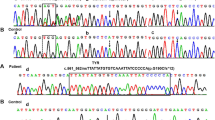Abstract
Background
Oculocutaneous albinism (OCA) is a congenital genetic disorder characterized by defects in melanin production. OCA type 1 (OCA1) is the most serious and common type of OCA. This study characterized mutations associated with OCA1 in a series of Chinese patients.
Methods
We recruited 41 unrelated patients with OCA and 100 healthy subjects from the Chinese Han population. Genomic DNA was extracted from their blood samples. Mutational analysis of tyrosinase (TYR) genes was conducted using polymerase chain reaction (PCR) and direct sequencing, specifically to test the 100 control subjects and exclude the possibility of polymorphism. Mutational analysis and bioinformatics study were performed in TYR mutations.
Results
Among the 24 (58.5%) patients with OCA1, 21 different TYR mutations were identified, including three previously unidentified alleles (PUAs): one frameshift mutation (c.216delA) and two missense mutations (A241T and N364K). The proband mutation A241T carries three possible mutations in complex OCA.
Conclusion
The findings of this study expand current knowledge and data of mutations associated with OCA1 in China and allow us to estimate or explore the mutation spectrum and relative frequencies of the TYR gene in the Chinese population.
Similar content being viewed by others
References
King RA, Hearing VJ, Creel DJ, Oetting WS. Albinism. In: Scriver CR, et al, editor. The metabolic and molecular bases of inherited disease, 7th ed.. New York: McGraw-Hill Inc. Health professions division, 1995, p. 4353–4393.
Scriver CR, Beauded AL, Sly WS, et al. The metabolic and molecular bases of inherited disease. McGraw-Hill, 2001, 8th ed: 5587–5627.
Grønskov K, Ek J, Brondum-Nielsen K. Oculocutaneous albinism. Orphanet J Rare Dis 2007; 2: 43.
Gong Y, Shao C, Zheng H, Chen B, Guo Y. Study on genetic epidemiology of albinism. Yi Chuan Xue Bao 1994; 21: 169–172.
Suzuki T, Tomita Y. Recent advances in genetic analyses of oculocutaneous albinism types 2 and 4. J Dermatol Sci 2008; 51: 1–9.
Hutton SM, Spritz RA. Comprehensive analysis of oculocutaneous albinism among non-Hispanic Caucasians shows that OCA1 is the most prevalent OCA type. J Invest Dermatol 2008; 128: 2442–2450.
Grønskov K, Ek J, Sand A, et al. Birth prevalence and mutation spectrum in Danish patients with autosomal recessive albinism. Invest Ophthalmol Vis Sci 2009; 50: 1058–1064.
Giebel LB, Strunk KM, Spritz RA. Organization and nucleotide sequences of the human tyrosinase gene and a truncated tyrosinase related segment. Genomics 1991; 9: 435–445.
Oetting WS, King RA. Molecular basis of albinism: mutations and polymorphisms of pigmentation genes associated with albinism. Hum Mutat 1999; 13: 99–115.
Takeda A, Tomita Y, Okinaga A, Tagami H, Shibahara S. Functional analysis of the cDNA encoding human tyrosinase precursor. Biochem Biophys Res Commun 1989; 162: 984–990.
Lerner AB, Fitzpatrick TB, Caukins E, Summerson WH. Mammalian tyrosinase; preparation and properities. J Biol Chem 1949; 178: 185–195.
Schnur RE, Selling BT, Holmes SA, Wick PA, Tatsumurs YO, Spritz RA. Type I oculocutaneous albinism associated with a full-length deletion of the tyrosinase gene. J Invest Dermatol 1996; 106: 1137–1140.
Toyofuku K, Wada I, Spritz RA, Hearing VJ. The molecular basis of oculocutaneous albinism type I (OCA1): sorting failure and degradation of mutant tyrosinase results in a lack of pigmentation. Biochem J 2001; 355: 259–269.
Aihua Wei, Xiumin Yang Shi Lian, Wei Li. Implementation of an optimized strategy for genetic testing of the Chinese patients with oculocutaneuous albinism. J Dermatol Sci 2011; 62: 124–127.
Fryer JP, Oetting WS, King RA. Identification and characterization of a DNAse hypersensitive region of the human tyrosinase gene. Pigment Cell Res 2003; 16: 679–684.
Author information
Authors and Affiliations
Corresponding author
Additional information
Both authors contributed equally.
About this article
Cite this article
Lin, Yy., Wei, Ah., He, X. et al. A comprehensive study of oculocutaneous albinism type 1 reveals three previously unidentified alleles on the TYR gene. Eur J Dermatol 24, 168–173 (2014). https://doi.org/10.1684/ejd.2014.2304
Received:
Published:
Issue Date:
DOI: https://doi.org/10.1684/ejd.2014.2304




